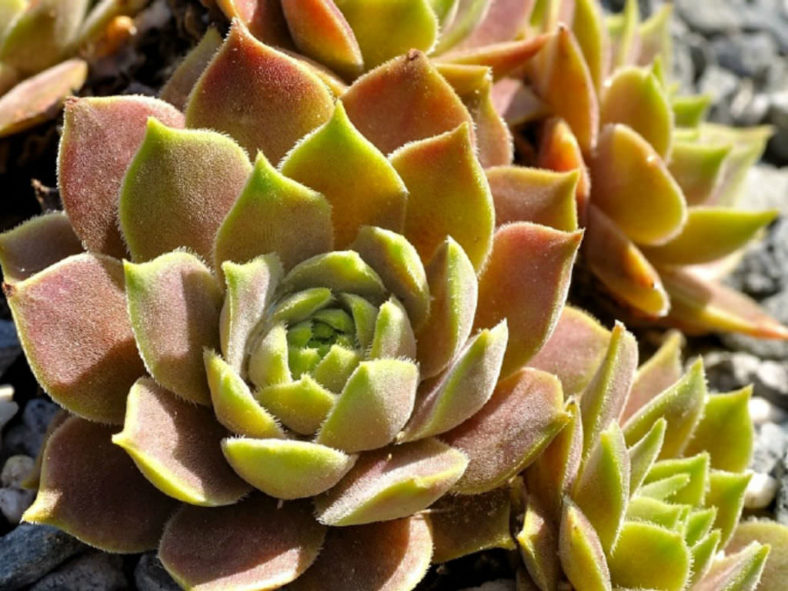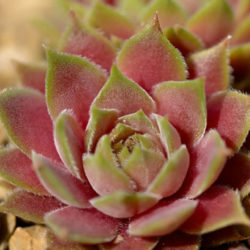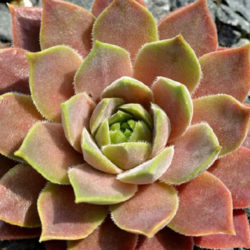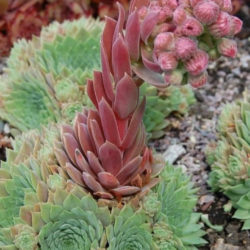Scientific Name
Sempervivum marmoreum subsp. erythraeum (Velen.) B.J.M. Zonneveld
Common Name(s)
Hen and Chicks, Houseleek
Synonym(s)
Sempervivum erythraeum, Sempervivum marmoreum var. erythraeum, Sempervivum montanum var. erythraeum
Scientific Classification
Family: Crassulaceae
Subfamily: Sedoideae
Tribe: Sedeae
Subtribe: Sedinae
Genus: Sempervivum
Description
Sempervivum marmoreum subsp. erythraeum, also known as Sempervivum erythraeum, is a small succulent that forms flattish rosettes of velvety leaves usually tinged with rose-red. The rosettes grow up to 2.4 inches (6 cm) in diameter, producing many offsets on short stolons, forming a compact tuft. Leaves are fleshy, pointed, and densely ciliate on margins with hairs of unequal length.
The star-shaped flowers with deep pink petals with a purplish-red median stripe appear on an erect, up to 8 inches (20 cm) tall, leafy stalk that arises from the center of the rosettes. They are 11- to 14 merous and up to 1 inch (2.5 cm) in diameter. The rosette dies after flowering.
Origin
Sempervivum marmoreum subsp. erythraeum is native to Bulgaria. It grows on alpine and subalpine rocks at elevations between 3,280 and 8,200 feet (1,000 and 2,500 m).

Hardiness
USDA hardiness zone 4a to 9b: from −30 °F (−34.4 °C) to 25 °F (−3.9 °C).
How to Grow and Care
Sempervivums are not difficult to grow, provided they are not waterlogged and killed from excess watering. They can be easily grown outdoors and in containers, and they earned the name "Houseleeks" from their tendency to root on the roofs of houses. After the mother plant flowers, it will naturally die, but the plant has likely produced many offsets that will continue to grow by this time. These are excellent for cold windows. Sempervivum earned their popular name, "Hen and Chicks," from their growth habit. The mother plant, or hen, sends off numerous offsets clustered around her base like chicks. These offsets can be easily repotted, or the plants can be left to form a clumping mat.
Repot as needed, preferably during the warm season. To repot a succulent, ensure the soil is dry before repotting, then gently remove the pot. Knock away the old soil from the roots, removing any rotted or dead roots. Treat any cuts with a fungicide. Place the plant in its new pot and backfill it with potting soil, spreading the roots out as you repot. Leave the plant dry for a week or so, then begin to water lightly to reduce the risk of root rot.
See more at How to Grow and Care for Sempervivum.
Links
- Back to genus Sempervivum
- Succupedia: Browse succulents by Scientific Name, Common Name, Genus, Family, USDA Hardiness Zone, Origin, or cacti by Genus
Photo Gallery
Click on a photo to see a larger version.


